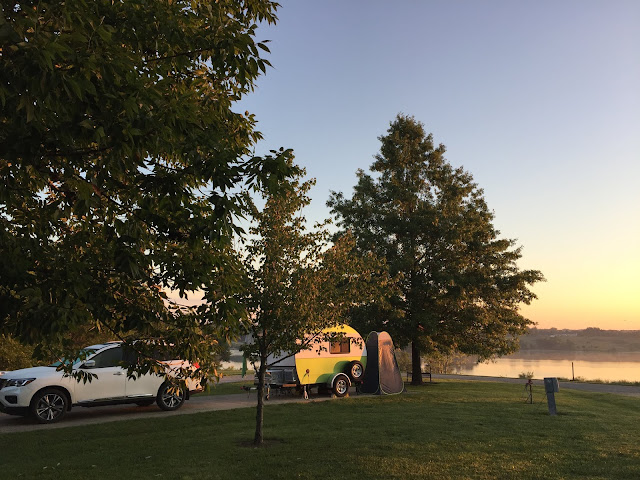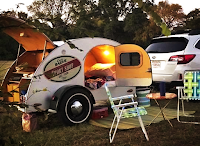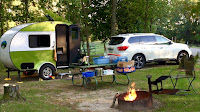Judging from the photos posted on social media, tiny trailer owners Lee and Lori Gandy have many opportunities to camp in beautiful spots in South Carolina . . . and they are taking full advantage of those opportunities. These two happy campers have owned their
Rustic Trail Teardrop Camper for one and a half years. It's a Grizzly model, a bit taller than the Papa Bear teardrop, yet still short enough to fit into a garage.

Fortunately for us, the Gandys enjoy framing evocative photographs of the pleasures of kicking back at a beautiful campsite and enjoying the moment. To quote Lee: "I. Love. Camping." In the year and a half that they have owned their Grizzly, Lee and Lori have camped "about 14 times, about ninety percent of our camping in South Carolina state parks (there are 46 of them!)"
Towing their Grizzly to some idyllic location has never been a problem for the Gandys. They now own a 2013 Toyota Highlander Limited, but "started towing with a 2001 Nissan Xterra but upgraded to a more comfortable vehicle. Both of these vehicles have a 5,000 pound towing capacity. Both vehicles tow the teardrop with ease. I did not add brakes to the camper and it has never been an issue."
 |
| The tow package: "I'm thrilled with how the Highlander tows, btw." |
 |
| Santee State Park, South Carolina |
Although the Gandys have owner their RTTC Grizzly only a year and a half, they are not new to camping. "We loved the idea of tent camping and did some tent camping, but because of weather issues, humidity, and the lack of sleeping well with tent camping, we did very little." They thought that one "tiny" change would make a difference, and it did!
"We chose a teardrop because we basically wanted an 'air conditioned tent on wheels' so we can camp on any given weekend without a lot of prep time. We also knew that if we had to store a camper somewhere, the inconvenience of going to get it and prep it before camping would hinder us from using it, especially for short trips. The teardrop fits in our garage where it is sheltered from the elements. We can literally decide to go camping one moment, and leave the house with the teardrop in tow within 30 minutes. We like the outdoor benefits of camping, so we basically only need a comfortable place to sleep as we spend most of our time outside while camping."
And the time Lee and Lori spent outdoors while camping is an inspiration: hiking, bicycling, kayaking--they are definitely "on-the-go" campers.
 |
| Muriel's Inlet, South Carolina |
 |
| Hike that trail! Stumphouse Mountain, SC |
 |
| Tiny trailer, bikes, kayaks--bring it on! |
The Gandys have created an effective blend of activity and rest for their camping pleasure. "When we camp, we look for places that have two things available: a river, lake, or really any body of water that we can canoe, and trails for our mountain bikes. We also purposefully find sites where we can set up our hammocks. We favor the mountains, but really anywhere that has woods and a body of water is great with us." And their favorite time of year to camp? "Hands down, we do most of our camping in the late fall through early spring time of the year. We like the cooler weather, lack of bugs and snakes, and less crowded conditions at the parks. We are both teachers so we love to camp during the Thanksgiving break, and usually twice during the Christmas break."
Their ability to put together a great camping experience is not lost on others. Their best experiences "are the looks we get as we drive through towns...we see people pointing out our camper to others...people stop us to say something about our camper...strangers wanting to know about it, see inside it, etc. We love that." It looks like the Gandys have "getting away from it all" down to a science.
Their camping experiences have resulted in some changes to Lee and Lori's rig and equipment. "We added a mini-fridge and a small microwave to the inside of our camper. This allows us to keep our food items in the fridge after we get set up. We keep our drinks in a cooler outside. We added a diamond plate aluminum toolbox to the tongue of the camper so that we can store the 'outside' equipment in it (wheel chocks, water hose, extension cords, etc.) I do not have a 'chuck box' as I prefer to be able to set my kitchen up wherever it's most convenient at any given campsite. We use a tailgate tent to set up in front of the camper. One of our favorite camping accessories is the 'Lil Red Campfire' (propane campfire in a can). We love building real fires, but this makes it easy to have instant heat for cold/wet mornings. I replaced the fake logs with black lava rock which makes for a beautiful flame."
 |
| Set up and ready for fun |
No wonder the Gandys enjoy camping. They have a rig they really like, they've added useful modifications to it, and they've included enough extras to make their stay outdoors a fun and relaxing experience. Based on their experience, their advice to new campers is to "practice at home before you take the camper out. Set it up, level it, sleep in it. This will give you confidence when you take it out the first time. Make a checklist of everything you need so that you don't forget anything. Go watch a million YouTube videos about tiny trailer camping!"

Although they are both busy schoolteachers, the Gandys still have plans to take out their rig and get away. They are planning their first extended road trip for the summer of 2019. "We plan on driving the entire I-77 corridor from SC to Lake Erie in Ohio. We will camp in the mountains of Virginia and stay at a state park on the Great Lakes...then head to Michigan. We will have one night in a hotel just to get "reset" (do laundry, restock, etc.) Our big dream is to drive out West (Grand Canyon, Yellowstone, and up to Oregon) one summer.
With their great tow vehicle and trailer, and with all the fine-tuned, choice camping equipment packed away, we're sure the Gandys will have great fun on their grand adventures. Keep your eyes peeled for a little turquoise and white teardrop, and if you see them, be sure to give a friendly wave, for without a doubt, you'll get one back!
(To read all the Green Goddess Glamping owner profiles, check out the
Owner Profiles page. Click the link or the Owner Profiles button beneath the header photo.)

























